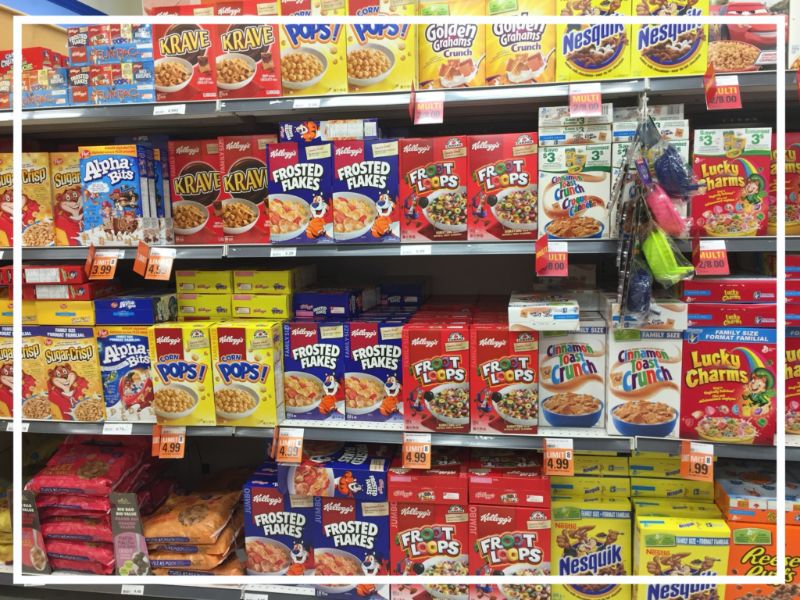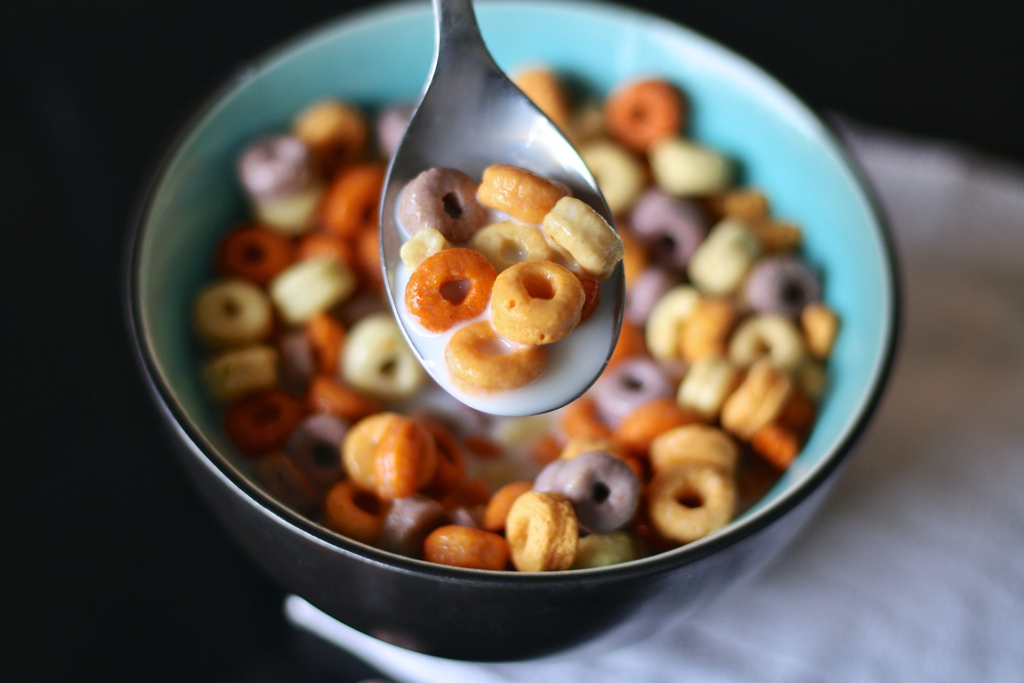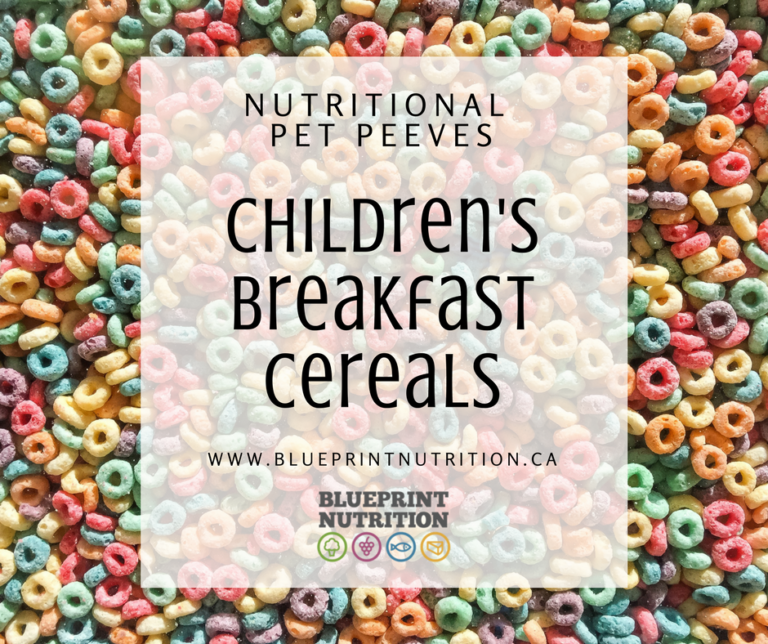If you follow my blogs regularly, you know that I like to go on a good rant. (If you’re new here, check out some of my latest rants, here and here). I do have a fairly lengthy list of what I will call “nutritional pet peeves” pertaining to misconceptions, false marketing, and/or nutritional food products or supplements that irk me to no end and make my eyes roll backwards at least a few times a day!
So, I figured on this chilly fall day in October in Ontario Canada, why not bring some sunlight to your day and enlighten you about one of my biggest pet peeves in the world of nutrition that has been irritating me now for a good 5+ years.
(P.S. I promise that I won’t inundate you with this type of post but whenever a doozy comes up that just needs to be unleashed, I will do the honours!)
So, without further adieu, here is my first nutritional pet-peeve, which my hubby can attest to …
Children’s Breakfast Cereals
Ugh.
Just thinking about it makes me shudder and send chills up my spine.
Don’t get me wrong, my heart sings a happy song when I give my kids a big bowl homemade granola or museli. But if it was my choice, children’s breakfast cereals (and the many other adult-targeted cereals) would not exist.
Funny enough, during our recent travels to Italy when we went grocery shopping, the “cereal” aisle consisted of maybe five different cereals, if that, many of which were unsweetened muesli. Enter any Canadian major grocer and you will find a full aisle about one kilometer in length of breakfast cereals.
An entire aisle folks! No joke. I took a picture of only an eighth of a cereal aisle this past week. CRAZY!

So why do breakfast cereals cause my heart rate to sky-rocket? Specifically, children’s breakfast cereals? Well, let’s look at a study that was hot off the press as of September 2017 to help make my point.
NEW Canadian research on child-targeted breakfast cereals
This study was a relatively simple one whereby the researchers collected data on the nutritional content of 262 unique cold breakfast cereals from the five largest grocery store chains in Ottawa Ontario and Gatineau Quebec. These chains included Loblaws, Sobeys, Metro, Costco and Wal-Mart.
The researchers collected information from the nutrition facts panel and ingredient list to record nutrients of concern, as well as the first five ingredients and the number of added sugars in each cereal. Then they used a nutrient model to classify cereals as “healthier” or “less healthy”. Cereals were deemed to be child-targeted if they featured candy, cartoons, child-directed messages, encouraged interaction (e.g. via puzzles, games), mentioned children in their name or logo, included tie-ins to children’s TV shows/movies or used primary colours or cartoon-like font.
The findings?
Overall, 20% of all cold breakfast cereals were targeted to children. That doesn’t seem too horrific yet, right? However, if we dive further into the difference between child-targeted cereals vs. those that are not, things turn south really quickly.
Here’s a snapshot of the results:
- Approximately 85% of child-targeted cereals fell into the “less healthy” category!!
- Cereals targeted to children were three times more likely to be classified as “less healthy” than those not intended for children’s consumption.
- Cereals targeted towards children were significantly
- higher in salt and sugar
- lower in fibre, protein, total fat and saturated fat
- NONE of the child-targeted cereals were sugar-free (surprise, surprise!)
- 60% of the child-targeted cereals contained on average 2 to 3 kinds of added sugars
- Sugar was the most common second ingredient in 75% of the child-targeted cereals
- 100% of the child-targeted cereals owned by General Mills, Metro, Nature’s Path Foods, Post, Quaker and Sally’s were grouped as “less healthy”
- Weetabix was the only company that had a greater number of “healthier” cereals

So what irks me the most about children’s breakfast cereals?
1) Too much sugar
This study demonstrated that there are on average 30 grams of sugar per 100 grams of cereal. In other words, if your child eats 30 grams of a sweetened cereal (about a 3/4 cup serving of a light-weight cereal), he or she would get a whopping 9 grams or 2 1/4 teaspoons of added sugar.
Is this a lot of sugar? I think so. Especially given that recommendations from the American Heart Association (AHA) and World Health Organization (WHO) want kids to limit their intake of sugar to less than 25 grams or 6 tsp daily – which isn’t a GOAL friends, it’s more like an upper limit.
This amount of sugar at breakfast is worrisome considering breakfast is only ONE (of many) opportunities during the day when children might eat added sugar – cue cookies, juice, desserts, flavoured yogurt etc. And let us not forget the fairly strong evidence linking the intake of added sugar to obesity.
2) Too little fibre
On average, the child-targeted cereals had about 5 grams of fibre per 100 g serving. Again, taking this to a more reasonable 30 gram (i.e. 3/4 cup) serving, that means we are getting ONE gram of fibre! WOW! Hold onto your hat!!
Did you know that kids 4-13 years need 25-31 grams of fibre daily (depending on age and gender)? If our kids are not getting any fibre at breakfast in the morning (p.s. there is no fibre in milk) then they have a heck of a ways to go for the rest of the day!
3) Lack of protein
I know that not every single food can “have it all” but most cereals are low in protein, like 1 gram per serving. However, cereal does tend to get served with milk, which (if you are drinking cow’s milk or soy milk) has a good source of protein. As I mentioned in this blog post, protein is important for growing kids and ideally we would like to spread it out over the course of a day, so getting some during your morning meal is ideal.
Are children’s breakfast cereals REALLY the problem? Don’t they contribute strongly to overall nutrient intake?
If you have read any of the systematic reviews re: breakfast cereal consumption, you would know that they tend to show that breakfast cereals contribute highly to overall nutrient intake. A recent review from 2016 demonstrated that children and adolescents who ate breakfast cereal 5 or more times per week had higher intakes of fiber and carbohydrates and an overall reduction in total fiat intake and cholesterol. Cereals can play a key role in reducing micronutrient deficiencies and encouraging milk intake.
However, this review also showed that total sugar intake was higher among cereal eaters – some of which will come from the natural sugar in milk but much of it will also come from added sugars in cereal, of which we know there are many.
And as I have mentioned before, it is VERY important to look at the research with a fine-toothed comb and to take note of the following:
1) Type of studies. Systematic reviews group results from individual studies together and many of the individual studies are cross-sectional and observational (i.e. cohort studies). Far fewer are RCTs or randomized controlled trials, which are a much stronger study design.
2) Funding source. In the review discussed above, the authors clearly acknowledged the limitation that many of the studies included were funded by food industry. This was evident as well in a recently published Australian study from 2017 which was funded by the Australian Breakfast Cereal Manufacturers Forum of the Australian Food and Grocery Council.
I fully realize that big brands have the money to fund research and to run these large studies, you sort of have to shake hands with the devil. However, having worked for PhD students running research studies in the past, I can personally attest to how this funding can sway the results.

So what is the alternative to “kid-friendly” cereal?
I do not believe that children’s breakfast cereals are going away anytime soon, much to my dismay. So, what are we to do as parents to navigate the landmines located with the cereal aisle?
My top 5 tips to boost nutrition at breakfast:
1) Drop the kiddie cereal cold turkey!! If you don’t bring it into the house then you do not need to draw battle lines with your children. It’s as simple as that. If your child is struggling with picky eating and sugary cereal is the only thing that he or she will eat, please contact us for help.
2) Choose healthy cereals!! Create a short-list of cereals that you will purchase, which fulfill the following criteria (note: this is my 4-5-6 rule of thumb):
- At least 4 grams of fibre per listed serving
- BONUS: 5 grams of protein per listed serving
- Less than 6 grams of sugar per listed serving
Here are a few cereals amongst a variety of brand names to get you started (note that these are NOT child-targeted cereals and do not necessarily have the bonus 5 g of protein): Alpen no-added sugar muesli, Post shredded wheat, Love Grown Power Os original, Nature’s Path organic flax plus multigrain flakes, Quaker Life cereal multigrain, Weetabix Grain Shop high fibre crisp cereal.
3) Bump up the nutrition!! Can’t find any cereals your kids like that fulfill the above criteria? Keep something like Cheerios on the short list (it is one gram short of having 4 grams of fibre) but add ground flax, hemp seeds and berries to bump up the healthy fat, fibre and protein content.
4) Get creative with breakfast offerings!! Create 5-7 breakfast cards and have your kids choose what they want for breakfast the night before. Choice is empowering for children!! Options might include high protein pancakes, stove-top hot oatmeal, overnight oats, smoothies, plain Greek yogurt and whole grain toast, scrambled or hard boiled eggs and smashed avocado toast.
5) Eat lunch or supper for breakfast!! We often hear of people eating breakfast for supper (or brupper) but we don’t hear of the reverse lunch or supper for breakfast (lufast or sufast). Remember that you don’t have to just eat “breakfast foods” for breakfast. If you have leftover chicken black bean quesadillas and they like those, give that a try. Keep thinking outside of the box.
What are some of your nutritional pet peeves?! Feel free to leave a comment below and I will try to incorporate some of your top pet peeves as possible.
Take it one bite at a time,
Rosanne
References:
- The healthfulness and prominence of sugar in child-targeted breakfast cereals in Canada. Potvin et al. Health Promot Chronic Dis Prev Can. 2017 Sep;37(9):266-273.
- Guideline: Sugars intake for adults and children. Geneva: World Health Organization; 2015.
- Added sugars and cardiovascular disease risk in children: a scientific statement from the American Heart Association. Dos et al. Circulation. 2016.
- The nutritional quality of New Zealand breakfast cereals: an update. Chepulis et al. Public Health Nutr. 2017 Sep 7:1-4.
- Effects of Ready-to-Eat-Cereals on key nutritional and health outcomes: A systematic review. Price et al. PLoS ONE, 2016. 11(10)
- Breakfast and Breakfast Cereal Choice and Its Impact on Nutrient and Sugar Intakes and Anthropometric Measures among a Nationally Representative Sample of Australian Children and Adolescents. Fayet-Moore et al. Nutrients. 2017 Sep 21;9(10).








